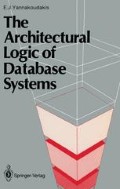Abstract
In previous chapters we discussed the DBMS and database from a number of different angles as well as the types of users, architectural levels, structures and models necessary to describe the database. This chapter presents database software under well defined modules (languages or sublanguages — all part of the overall DBMS) and outlines the main objectives and tasks performed by each.
Access this chapter
Tax calculation will be finalised at checkout
Purchases are for personal use only
Preview
Unable to display preview. Download preview PDF.
References
ANSI, X3H2 Technical Committee on Databases, X3H2 Technical Committee on Databases, ‘Relational Database Language’, 1986.
CODASYL, Report of the CODASYL Data Description Language Committee, Pergamon Press, 1978.
Cosmadakis, S. & Papadimitriou, C. H. H., ‘Updates of Relational Views’, Proc. ACM SIGAT-SIGMOD Symposium on Principles of Database Systems, March 1983.
Date, C. J. J., ‘An Introduction to Database Systems’, Vol. II, Addison-Wesley, 1984.
Duyn, J. Van, ‘Developing a Data Dictionary System’, Prentice-Hall, 1982.
Furtado, A. L. & Casanova, M. A., ‘Updating Relational Views’, In: Query Processing in Database Systems, Kim W., Reiner D. & Batory D. (editors), Springer Verlag, New York, 1986.
Gittins, D., ‘Query Language Systems’, Edward Arnold, 1986.
Goldfine, A., ‘Using the Information Resource Dictionary System Command Language’ ISO TC97/SC21 N474, 1984.
Kahn, B. K. & Lumsden, E. W., ‘A User-oriented Framework for Data Dictionary Systems’, ACM SIGBDP, Vol. 15, No. 1, pp. 28–36, 1983.
Sordi, J. J., ‘The Query Management Facility’, IBM Systems J., Vol. 23, No. 2, pp. 126–150, 1984.
Teorey, T. J. & Fry, J. P., ‘Design of Database Structures’, Prentice-Hall, 1982.
Yannakoudakis, E. J. & Cheng, C. P., ‘A Rigorous Approach to Data Type Specification’, Computer Bulletin, Vol 3, Part 4, pp. 31–36, 1987.
Zloof, M. M., ‘Query-By-Example: A Database Language’, IBM Systems J., Vol. 16, No. 4, pp. 324–343, 1977.
Zloof, M. M., ‘QBE/OBE: A Language for Office Business and Office Automation’, Computer, pp. 13–22, May 1981.
Author information
Authors and Affiliations
Rights and permissions
Copyright information
© 1988 Springer-Verlag Berlin Heidelberg
About this chapter
Cite this chapter
Yannakoudakis, E.J. (1988). The Architecture of Database Software. In: The Architectural Logic of Database Systems. Springer, London. https://doi.org/10.1007/978-1-4471-1616-5_4
Download citation
DOI: https://doi.org/10.1007/978-1-4471-1616-5_4
Publisher Name: Springer, London
Print ISBN: 978-3-540-19513-9
Online ISBN: 978-1-4471-1616-5
eBook Packages: Springer Book Archive

